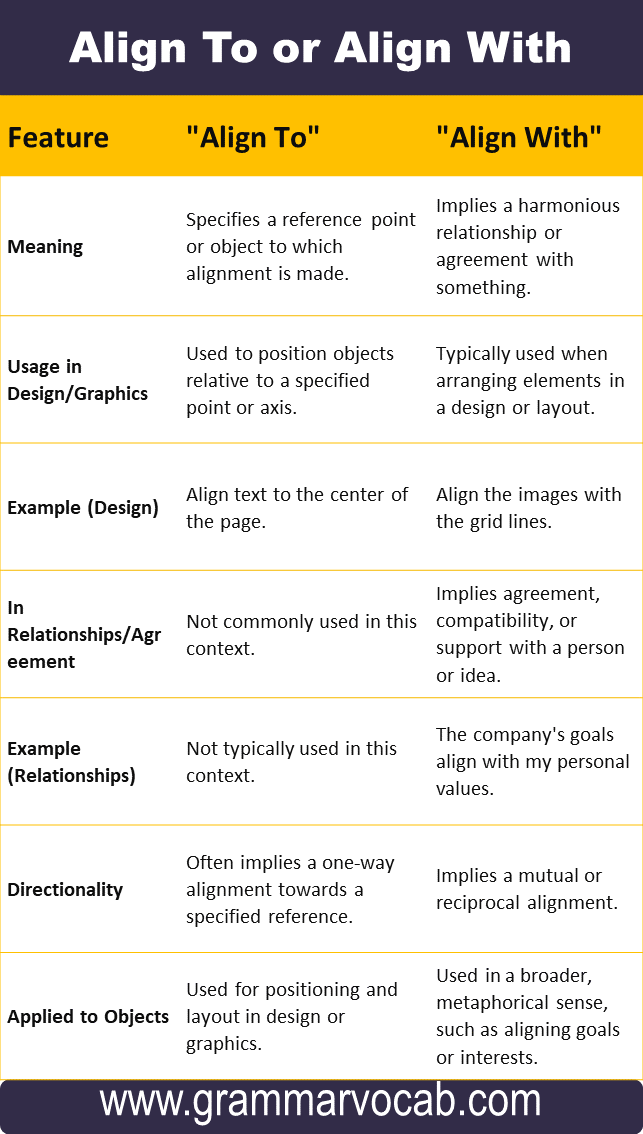Language is a powerful tool that evolves over time, shaping and reshaping itself to meet the needs of its users. However, amidst this evolution, certain grammatical nuances may create confusion. One such perplexity arises when deciding between “align to” and “align with.” In this article, we’ll delve into the intricacies of these phrases, exploring their meanings, contexts, and the correct usage in different situations.
Understanding “Align To”:
First, let’s look at “align to.” When you align something to something else, you are positioning it in a straight line or adjusting it to match a specific direction. It’s like placing things side by side to make sure they are in a proper order or arrangement. For example, you might align the edges of two pieces of paper to create a neat stack.
Example Sentences
- Ensure the document edges align to avoid printing issues.
- Actions should align to your core values for fulfillment.
- Teaching methods should align to diverse learning styles.
- Calibrate the instruments to align to accurate measurements.
- Choose investments that align to your ethical principles.
Understanding “Align With”:
On the other hand, “align with” suggests a sense of agreement, harmony, or collaboration. When you align with someone or something, you are joining forces, sharing common goals, or working together towards a shared objective. This usage is more about being in sync or having a mutual understanding. For instance, a team might align with the company’s mission to achieve success.
Example Sentences
- Your goals should align with your values for a meaningful life.
- To achieve success, your actions must align with your aspirations.
- It’s important for your actions to align with your words to build trust.
- The company’s mission statement should align with its business practices.
- Make sure your daily tasks align with your long-term objectives.
- Ensure that your decisions align with your overall strategy for consistent progress.
Differences Between “Align To” and “Align With”
“Align to” and “align with” are phrases that are often used in different contexts, and the specific meaning can vary depending on the context in which they are used. Here’s a general comparison table highlighting key differences:
| Feature | “Align To” | “Align With” |
| Meaning | Specifies a reference point or object to which alignment is made. | Implies a harmonious relationship or agreement with something. |
| Usage in Design/Graphics | Used to position objects relative to a specified point or axis. | Typically used when arranging elements in a design or layout. |
| Example (Design) | Align text to the center of the page. | Align the images with the grid lines. |
| In Relationships/Agreement | Not commonly used in this context. | Implies agreement, compatibility, or support with a person or idea. |
| Example (Relationships) | Not typically used in this context. | The company’s goals align with my personal values. |
| Directionality | Often implies a one-way alignment towards a specified reference. | Implies a mutual or reciprocal alignment. |
| Applied to Objects | Used for positioning and layout in design or graphics. | Used in a broader, metaphorical sense, such as aligning goals or interests. |
Common Mistakes:
People often mix up these phrases, leading to confusion. Here are a couple of examples of common mistakes and how to correct them:
Incorrect: “We need to align our goals to the new strategy.”
- Correct: “We need to align our goals with the new strategy.”
Incorrect: “Please align the chairs with the table.”
- Correct: “Please align the chairs to the table.”
Must Try:
As If or As Though
On Bed or In Bed




